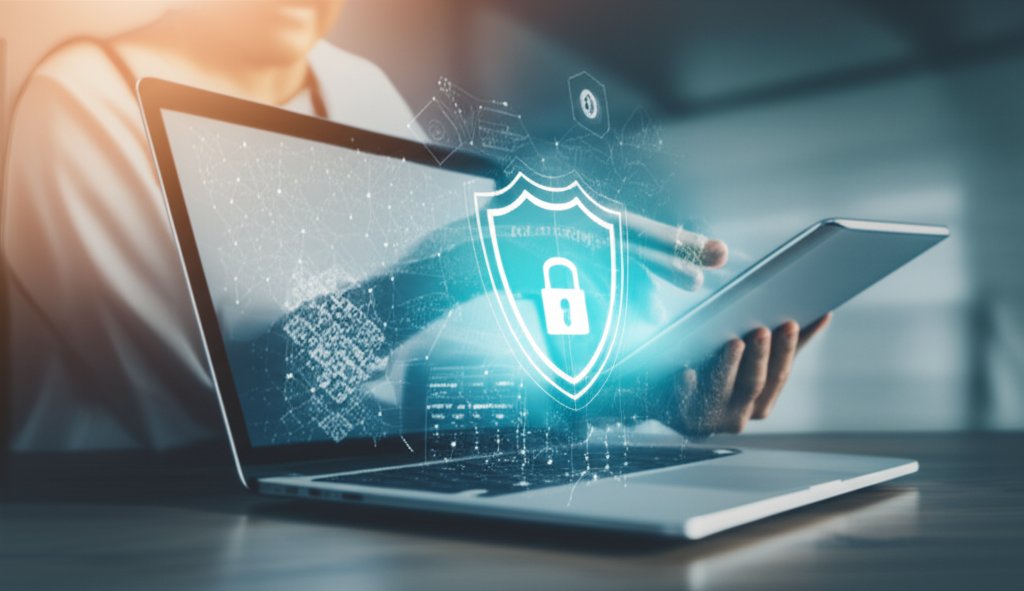The Rise of AI Phishing: Your Non-Tech Guide to Fortifying Your Digital Defenses
In our increasingly connected world, staying secure online isn’t just a recommendation; it’s a necessity. We’ve all heard of phishing – those pesky, often poorly written emails trying to trick us into revealing sensitive information. But what if I told you that threat is evolving, becoming far more insidious thanks to artificial intelligence? We’re not just talking about minor typos anymore; AI is supercharging cyberattacks, making them incredibly difficult to spot, even for a trained eye. It’s time for us to truly fortify our digital defenses.
For everyday internet users and small businesses, this isn’t abstract tech talk. It’s a clear and present danger that can lead to data breaches, significant financial losses, and irreparable reputational damage. But don’t worry, we’re not here to alarm you without offering solutions. My goal is to empower you with practical, non-technical strategies to protect yourself and your business against these advanced cyber threats. Let’s explore how AI is changing the game and, more importantly, how you can stay one step ahead.
What Exactly is AI-Powered Phishing?
You might be thinking, “Phishing? I know what that is.” And you’re right, to an extent. Traditional phishing attacks have long relied on volume, casting a wide net with generic emails riddled with grammatical errors, suspicious links, and urgent, but often clumsy, requests. They were often easy to spot if you knew what to look for, betraying their malicious intent through obvious flaws.
Beyond Traditional Phishing
Now, imagine those same attacks, but with perfect grammar, context-aware messaging, and a highly personalized touch. That’s the profound difference AI brings to the table. Generative AI tools, especially Large Language Models (LLMs), have become readily available, and unfortunately, cybercriminals are among the first to exploit their capabilities. They’re using these advanced tools to craft messages that are virtually indistinguishable from legitimate communications, stripping away the traditional red flags we’ve learned to identify.
The AI Advantage for Cybercriminals
How does AI help attackers? It allows them to:
- Craft Convincing Messages: AI can write persuasive, grammatically flawless emails that mimic human communication styles. This means no more easy-to-spot typos or awkward phrasing that used to give away a scam. An AI can mimic the writing style of your CEO or a trusted vendor with surprising accuracy.
- Scale Attacks Rapidly: Instead of manually writing thousands of emails, AI can generate countless unique, tailored messages in minutes, dramatically increasing the scale and success rate of phishing campaigns. This means a single attacker can launch a global campaign targeting millions, each message slightly different, making them harder for automated filters to detect.
- Overcome Language Barriers: AI can significantly aid in translating and localizing attacks, vastly expanding the global reach of cybercriminals. While this capability is incredibly potent, it’s important to understand that ‘perfectly’ is an overstatement; some weaknesses can still exist, especially in low-resource languages or where linguistic safeguards might allow for detection.
New Forms of Deception
The scary part is that AI isn’t just making emails better; it’s creating entirely new vectors for phishing that exploit our trust in familiar forms of communication:
- Hyper-Personalization (Spear Phishing on Steroids): AI can scrape public data from social media, company websites, and news articles to craft messages that feel incredibly personal and relevant. For example, an email might reference your recent LinkedIn post, a project you’re reportedly working on, or even a specific local event, making it seem utterly legitimate. Imagine an email appearing to be from a professional contact, mentioning a recent industry conference you both attended, and asking you to review “shared notes” via a link that leads to a credential harvesting site. This level of context makes it incredibly difficult to question its authenticity. This is sophisticated social engineering at its finest.
- Deepfakes (Voice & Video Cloning): This is perhaps the most alarming development. AI can now clone voices and even create synthetic video of individuals with startling realism. Imagine getting a phone call from what sounds exactly like your CEO, urgently requesting an immediate wire transfer to a new vendor, citing an emergency. Or receiving a video call from a “colleague” asking you to click a suspicious link to access a shared document. These vishing (voice phishing) and video scams are incredibly effective because they exploit our inherent trust in familiar faces and voices, bypassing our usual email skepticism.
- AI-Generated Fake Websites: Creating a perfect replica of a login page for your bank, email provider, or favorite online store used to require some design skill. Now, AI can generate near-perfect copies with minimal effort, even incorporating subtle elements that mimic real site behavior. You might receive a text message about an expired delivery label. Clicking it takes you to a logistics company website that looks identical to the official one, down to the tracking number format, asking for your credit card details to re-schedule delivery. You wouldn’t notice it’s fake until your information is stolen. This makes it almost impossible to discern a fake from the real deal just by looking.
Why AI Phishing is More Dangerous for Everyday Users and Small Businesses
This isn’t just a problem for big corporations with dedicated cybersecurity teams. In fact, you could argue it’s even more dangerous for individuals and small businesses, and here’s why:
- Bypassing Traditional Defenses: Those spam filters and basic email gateways that used to catch obvious phishing attempts? AI-generated attacks can often slip right past them. The perfect grammar, realistic tone, and lack of common red flags make these emails look “clean” to automated systems. A traditional filter might flag an email with unusual spelling, but an AI-generated message, crafted with perfect English and context, will likely sail through undetected, appearing harmless until a user clicks a malicious link.
- Exploiting Human Trust: We’re wired to trust. When a message is highly personalized, comes from a seemingly familiar source, or uses urgent language, our natural instinct is to react. AI preys on this, making it much harder for us to spot the deception, especially when we’re busy or distracted. If you receive a seemingly legitimate email from a known colleague, referencing an internal project and asking for a quick review, your guard is naturally lowered compared to a generic “Dear Customer” email.
- Limited Resources: Small businesses, unlike large enterprises, typically don’t have dedicated IT security teams, extensive budgets for advanced cybersecurity solutions, or round-the-clock threat monitoring. This makes them prime targets, as they often represent an easier path for attackers to gain access to valuable data or funds. They’re not “too small to be targeted”; they’re often seen as low-hanging fruit because their defenses are perceived to be weaker.
- Higher Success Rates: The numbers don’t lie. AI-generated phishing emails have been shown to have significantly higher click-through rates compared to traditional methods. When attacks are more convincing, more people fall for them, leading to increased incidents of data theft, ransomware, and financial fraud.
Fortifying Your Personal Defenses Against AI Phishing
The good news? You’re not powerless. A strong defense starts with vigilance and smart habits. Let’s fortify your personal shield.
Cultivate a Healthy Skepticism (Think Before You Click or Reply)
This is your golden rule. Critical thinking is your best weapon against AI deception. Adopt an “always verify” mindset, especially for urgent or unexpected requests.
- Scrutinize Sender Details Meticulously: Don’t just glance at the display name (e.g., “John Doe”). Always hover your mouse over the sender’s name or click to reveal the actual email address. Does it precisely match the expected domain (e.g., “johndoe@company.com” vs. “johndoe@companny.net” or “johndoe.company.support@mail.ru”)? Even legitimate-looking names can hide malicious addresses. For instance, if you get an urgent email from “Amazon Support,” but the sender’s email address is “support@amaz0n.co.uk.mail.ru” (with a zero instead of an ‘o’ and an unrelated domain), that’s an immediate red flag. For more insights, learn about critical email security mistakes you might be making.
- Verify Unexpected or Urgent Requests Independently: If you receive an urgent request for money, sensitive information, or immediate action, especially if it seems out of character or comes with intense emotional pressure, always verify it through a known, trusted method. Do NOT reply to the email or call the number provided in the suspicious message. Instead, use a contact method you already have on file – call the person directly using their known phone number, or log into the official website (e.g., your bank’s official site) to check for alerts. If your “bank” emails about a security alert, do not click any links in that email. Instead, open your browser, type in your bank’s official website address, and log in directly to check for messages.
- Examine Links Carefully Before Clicking: Before you click any link, hover your mouse over it (on a desktop) to see the full URL. On mobile, a long press often reveals the underlying URL. Does it look legitimate? Are there subtle misspellings, unusual domain extensions (like .ru, .xyz, or .cc when you expect .com or .org), or extra subdomains that seem out of place? If in doubt, don’t click. Manually type the website address into your browser instead. Consider an email from “Netflix” about updating your payment. Hover over the “Update Details” link. If it shows “https://netflix-billing.ru/update” instead of a legitimate Netflix domain, it’s a scam, even if the email text looked perfect.
- Beware of Urgency & Emotional Manipulation: AI is exceptionally adept at crafting messages designed to create panic, curiosity, or a false sense of urgency. Phishing attacks often play on emotions like fear (“Your account will be suspended!”), greed (“You’ve won a prize!”), or helpfulness (“I need your help immediately!”). Take a moment, breathe, and question the message’s true intent. Never let urgency bypass your critical thinking.
Strengthen Your Accounts Proactively
Even if an attacker manages to get your password, these steps can be critical in preventing a breach.
- Multi-Factor Authentication (MFA): This isn’t optional anymore; it’s absolutely essential for every account you have, especially email, banking, social media, and any services storing personal data. MFA adds a second, independent layer of verification (like a code sent to your phone, a fingerprint scan, or a hardware key) that an attacker won’t have, even if they manage to steal your password. It’s a critical barrier that can stop most credential theft in its tracks. Enable it everywhere it’s offered.
- Strong, Unique Passwords: While MFA is vital, don’t neglect password hygiene. Use a reputable password manager to create and securely store long, complex, unique passwords for every single online account. Never reuse passwords! A compromised password for one service shouldn’t give an attacker access to all your others. For an even more robust approach, explore passwordless authentication.
- Regular Software Updates: Keep operating systems, web browsers, and all security software (antivirus, anti-malware) on your devices patched and up-to-date. Attackers often exploit known vulnerabilities that have already been fixed by software updates.
Stay Informed: The threat landscape is constantly changing. Regularly update your knowledge about new scams, common attack vectors, and the latest deepfake techniques. Following reputable cybersecurity blogs and news sources can keep you informed and aware.
Protecting Your Small Business from AI-Powered Phishing
For small businesses, the stakes are even higher. A successful AI phishing attack can cripple operations, lead to significant financial loss, damage customer trust, and even threaten the business’s existence. But just like personal defenses, proactive measures and a layered approach can make a huge difference.
Employee Training is Paramount
Your employees are your first line of defense. They’re also often the weakest link if not properly trained for the nuances of AI-powered threats. Investing in them is investing in your security.
- Regular, Interactive Security Awareness Training: Don’t just lecture; engage your staff. Use simulated AI phishing attacks to prepare them for realistic threats. These simulations should mimic highly personalized messages, subtle domain spoofs, and even deepfake voice messages (using internal actors for voice, if possible, for training purposes). Make it an ongoing process, not a one-time event, with clear feedback and reinforcement. Employees need to experience what these sophisticated scams look and feel like in a safe environment.
- Focus on Deepfakes & Vishing: Train employees to question unusual requests made via voice or video calls, especially those involving financial transactions, sensitive data, or changes to vendor payment details. Establish clear, mandatory verification protocols. For example, implement a “two-person rule” or a mandatory call-back protocol: if the “CEO” calls asking for an immediate wire transfer to a new account, the employee must call the CEO back on a known, pre-established secure line (not a number provided in the suspicious call) to verify the request. Create a “code word” for sensitive verbal requests, known only to authorized personnel.
Leverage AI-Powered Security Tools
You don’t need to be a tech giant to benefit from advanced security solutions. Many accessible tools now incorporate AI to bolster defenses.
- Advanced Email Security Gateways: These aren’t just basic spam filters. Modern solutions use AI, machine learning (ML), and natural language processing (NLP) to detect sophisticated phishing attempts. They analyze email content, sender behavior, the intent behind messages, and even the email’s “journey” to block threats before they ever reach an employee’s inbox. You won’t get bogged down in technical jargon; these tools just work behind the scenes to protect you from the most insidious attacks.
- Endpoint Detection and Response (EDR) & Antivirus: Ensure all company devices (computers, laptops, mobile phones) have up-to-date antivirus and EDR solutions. These tools use AI to detect and neutralize malware that might be installed if an employee accidentally clicks a malicious link, providing a crucial safety net.
- URL and Attachment Scanners: Many advanced email security and endpoint protection tools automatically analyze links and “sandbox” (isolate and test in a safe virtual environment) email attachments for malicious content before they can harm your systems.
Implement a “Defense-in-Depth” Strategy
Think of your business’s security like layers of an onion. No single security measure is foolproof on its own. You need multiple, overlapping layers of security – from robust email filters and endpoint protection to strong firewalls and, most crucially, well-trained employees – to significantly reduce your risk. Adopting a Zero Trust strategy can further enhance these layers.
- Backup Data Regularly and Securely: While not a direct anti-phishing measure, regular, encrypted, and offsite data backups are absolutely crucial. Should a phishing attack lead to ransomware or data loss, having recent, secure backups can minimize the impact and allow for a quicker recovery, ensuring business continuity. Test your backups regularly to confirm they work.
- Implement Access Controls and Least Privilege: Limit employee access to only the data and systems absolutely necessary for their job functions. This “least privilege” principle means that if an attacker compromises one account, their access to critical systems and sensitive data is restricted, limiting the potential damage.
The Future of the AI Phishing Arms Race
It’s true, the landscape of cyber threats is constantly evolving. As attackers get smarter with AI, so do the defenders. We’re seeing continuous innovation in AI-powered security solutions designed to detect and neutralize these advanced threats, often using AI themselves to identify patterns of deception. This ongoing “arms race” means that staying informed and adaptable isn’t just a suggestion – it’s a necessity. We can’t afford to rest on our laurels, but we also don’t need to live in fear. We simply need to be prepared.
Conclusion: Staying One Step Ahead
The rise of AI-powered phishing is undoubtedly a serious challenge. It demands a heightened level of awareness and proactive security practices from all of us. But here’s the powerful truth: by understanding the new threats and implementing smart, practical defenses, both individuals and small businesses absolutely can protect themselves effectively. Vigilance, education, and leveraging the right tools are your greatest assets in this fight.
Key Takeaways:
- AI has transformed phishing, making attacks incredibly sophisticated and often indistinguishable from legitimate communications.
- Hyper-personalization, deepfake voice/video, and AI-generated fake websites are new, potent forms of deception.
- Your most powerful personal defenses are a healthy skepticism, rigorous independent verification of requests, meticulous scrutiny of sender details and links, and non-negotiable multi-factor authentication for all critical accounts.
- For businesses, continuous, interactive employee training (especially for deepfakes and vishing), combined with advanced AI-powered security tools and a layered “defense-in-depth” strategy, is essential.
Don’t feel overwhelmed. Instead, feel empowered. Take control of your digital security. The digital world is yours to secure! Start by implementing the practical tips we’ve discussed today. Make them a habit. Discuss these threats with your family, friends, and colleagues. For further resources and ongoing insights, follow reputable cybersecurity news outlets and consider consulting with trusted IT security professionals.









